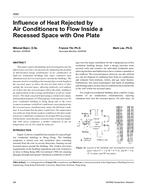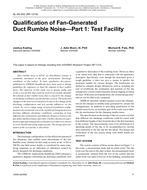The primary purpose of this study was to determine if the thermal comfort of subjects working at a moderate level of activity (2.3 MET) was improved or adversely affected by air motion. second purpose of the study was to compare experimental results with the predicted responses given by the Fanger thermal comfort model and the Azer thermal response model. Tests were conducted with subjects wearing 0.65 clo and 1.09 clo of clothing insulation and with relative air velocities of approximately 40 fpm (0.20 m/s) and 240 fpm (1.2 m/s). The air temperature was varied over a range selected to include the optimum comfort level. The results indicate that comfort is as good, if not better, with the higher air velocity. The experimental results showed a higher sensitivity to temperature than predicted by either model.
Units: Dual
Citation: Symposium, ASHRAE Transactions, 1986, vol. 92, pt. 2B, Portland, OR
Product Details
- Published:
- 1986
- Number of Pages:
- 9
- File Size:
- 1 file , 1.1 MB
- Product Code(s):
- D-PO-86-14-4


